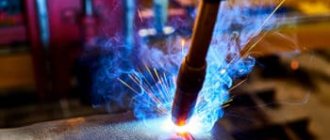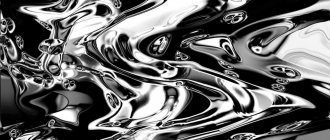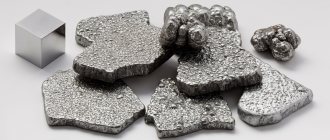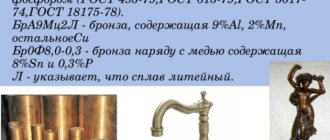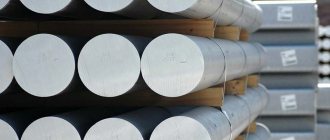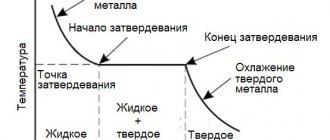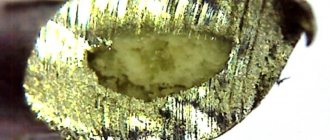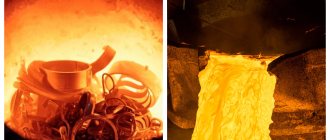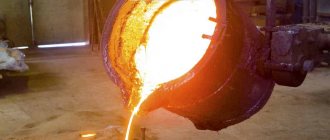Physical properties
Wear resistance, like corrosion resistance, is maintained at elevated temperatures.
However, this makes stellite difficult to process. The melting point is 1260–1300 °C. For PR-VZK and PR-VZK-R, the maximum surfacing temperature is 750 and 800 °C, respectively. These alloys are characterized by wear resistance to mechanical loads, chemically active environments, high temperatures, and sharpen well.
Stellite 6 is resistant to many chemical and mechanical factors over a wide temperature range (up to 950 °C), as well as cavitation corrosion and toughness. Melting occurs in the range of 1285–1410 °C. The density is about 8.44 g/cm3 (8.7 g/cm3 according to other sources).
Stellite 1 has a slightly reduced viscosity, which is compensated by increased resistance to abrasion and gentle erosion. Also, compared to other options, the alloy is more susceptible to cracking, and therefore requires slower cooling during surfacing. The density is 8.7 g/cm3, the melting temperature range is 1190–1345 °C.
Stellite 12 combines the qualities of the two previous types. It differs from the first by better resistance to slipping, friction, abrasion, gentle erosion, thermal influence with resistance to cavitation and high impact strength. The maximum application temperature is 700 °C, and melting occurs in the range of 1200-1365 °C. The density is 8.5 g/cm3.
As noted, the parameters of stellite 21 are largely determined by the processing history. In any case, it is focused on resistance to wear due to abrasion and sliding. Moreover, significant hardening of the surface during wear is possible. However, this type of alloy does not withstand abrasion from solid particles. In addition, the alloy in question is resistant to thermal influences and shocks.
Stellite can be colored anthracite grey, golden, red-brown and shades in between. The shine is negligible. The surface is rough, which is determined by the production technology.
Melting of stellene occurs in the range of 1285–1410 °C or 1295–1480 °C. Like stellite, these alloys are resistant to wear, cavitation, erosion, abrasion, corrosion, abrasion and chemical attack.
Precision fechral alloy
Rolled metal calculator
| Fechral belongs to the class of precision alloys with high electrical resistance, which determines its use as electric heaters. The page provides a description of this alloy: physical properties, applications, grades of fechral, types of products. |
Fechral is an iron-chromium-aluminum alloy consisting of the following elements: chromium Cr; aluminum Al; Fe. It is worth noting that the nickel content is only no more than 0.6%. The low nickel content makes this alloy cheaper than nichrome. The resistivity of fechral (nominal value) is 1.39 μOhm m, density is 7.21 g/cm3, melting point is 1500 °C (according to GOST 12766.1-90). Fechral has high operating temperatures (up to 1400 °C). Fechral has high electrical resistance, which is the main practically useful property of this alloy. Fechral products are characterized by heat resistance in an oxidizing atmosphere containing sulfur and sulfur compounds, carbon, and hydrogen. The alloy has high hardness, works in contact with high-alumina ceramics, and is not prone to pitting corrosion. The presence of iron in the composition of fechral negatively affects some properties of this alloy. Fechral is quite fragile, which complicates its processing to obtain the necessary products.
| Density of fechral, g/cm3 | 7,21 |
| Melting point, °C | 1500 |
| Magneticity | Ferromagnetic |
| Hardness, HB | 200-250 |
| Temperature coefficient of linear expansion, K-1 in the range 20-1000 °C | 15·10-6 |
| Specific heat capacity, kJ/kg K at 25°C | 0,48 |
Among the most common grades in production are fechral X23Yu5T, X27Yu5T. The most significant component in the composition of these brands is iron (Fe) 69-72% and 65-68%, respectively. The presence of iron reduces the cost of the fechral alloy, but at the same time worsens some of its properties. The second main component is chromium (Cr), the content of which is 22-24% and 26-28%, respectively. The percentage of aluminum is the same and equals 5-5.8%.
- Advantages:
- alloy with high electrical resistance;
- has a lower cost compared to nichrome due to the absence of nickel;
- has high heat resistance;
- allows the use of heaters at maximum operating temperatures up to 1400 °C.
- Flaws:
- has high fragility and insufficient strength;
- due to the presence of iron, fechral is magnetic and susceptible to oxidation;
- winding of spirals is possible only in a heated state;
- compared to nichrome, the number of on-off cycles of heating elements before their destruction is significantly less;
- can interact with fireclay lining and iron oxides;
- During operation, fechral heaters elongate significantly.
Fechral is used for the manufacture of heating elements for industrial and laboratory furnaces with a maximum operating temperature of 1400 °C. Heaters made from this alloy are also used in household heating appliances and electrical thermal devices. Among the household products in which fechral is widely used are electronic cigarettes.
Another application of fechral is the manufacture of resistive elements, for example, starting and braking resistors for electric locomotives.
The main types of fechral products produced by the industry are wire and thread (small diameter wire), as well as tape. In some cases, rods and circles are made from fechral. All of these products are used for the manufacture of round and flat heaters for electric furnaces.
What is nichrome
Nichrome alloy has good ability to resist electron flow. These unique properties make it suitable for applications in heating elements of hair dryers and heat guns. It has high oxidation resistance, which also makes it a suitable material for heating technology. Nichrome wire is wound into coils with a specific electrical resistance of nichrome through which a current is passed to produce heat.
Nickel-chromium 90/10 alloy is used in thermocouples in combination with Ni/Al 95/5 alloy. This combination is called chromel-alumel, represents heating elements with a maximum operating temperature of 1100 C and is subject to drift in the region of 1000 C due to oxidation. This effect is eliminated by adding silicon. Commercial grades include Nicrosil (containing 14% Cr and 1.5% Si) and Nisil (containing 4.5% Si and 0.1% Mg).
What does nichrome look like?
Nickel-chromium 80/20 metal is a high-temperature corrosion-resistant alloy used for wrought and cast parts because it has better resistance to oxidation and hot corrosion than cheap iron-nickel-chromium alloys.
Application area
Wire made from fechral is used in the production of heating elements, resistance parts and tubular heaters. The main direction is the production of heating electric furnaces of various capacities. The grade of fechral alloy used and the diameter of the wire affect the operating temperature of the furnace.
Fechral alloy X23Yu5T is considered the most heat-resistant. The maximum temperature to which a wire with a diameter of 6 mm is heated is 1400 degrees.
Fechral wire is used for the production of resistive elements for electrical equipment.
Due to their properties and technological characteristics, fechral thread and wire are used in various fields of industry, gradually replacing the expensive and inferior nichrome.
Wire: thickness, resistance and heating time
Wire can be made of various metals or alloys, but in addition to the material, there are other characteristics that can be used to most accurately describe the wire.
The first such parameter is the diameter of the wire, in Russia it is tenths of a millimeter, but in America there is such a thing as wire gauge. Wire of the required diameter is produced by drawing a larger wire through smaller holes, and the number of such drawings will be the caliber value. The higher this number, the smaller the diameter. The most popular calibers: 32, 30, 26, 24, 22.
The diameter of the wire usually determines its resistance (the smaller the area, the greater the resistance) and the time required to heat the wire (the smaller the cross-section, the faster the wire heats up).
Some vapers use the phrase “boost time” - this is the time it takes to heat the wire to the temperature at which the liquid in contact with it evaporates.
Types of scrap and waste of non-ferrous metals and alloys, marking, classification and categories of non-ferrous metals
Non-ferrous is a group of different metals and their alloys.
Let's take a closer look at what non-ferrous metal scrap is.
There are two groups of metals:
Iron and its alloys are called black.
The rest are non-ferrous or non-ferrous.
Their list is diverse:
- aluminum;
- copper;
- nickel;
- manganese;
- titanium;
- zirconium, etc.
All of them are in demand today both in production and in scientific activities. Their areas of application are varied.
Scrap metal collection points are happy to buy non-ferrous metal scrap at competitive prices, and in order to avoid getting into trouble when handing it over, you need to be familiar with the types and know the standard classification of non-ferrous metals.
Classification of non-ferrous metals according to GOST
The current GOST 1639-2009 clearly indicates what belongs to non-ferrous metal scrap.
The classification of scrap is divided into four main sections that characterize it:
- Name;
- physical parameters;
- chemical composition;
- quality.
GOST specifies the names of metals and their alloys.
The section displays 13 types that are accepted in organizations for receiving recyclable materials.
Below is a table in which you can see a list of non-ferrous metals in one list and the number of individual types of scrap:
Pure metal can rarely be found when delivered to recycling centers, since the majority of scrap is made up of alloys.
This ratio can be determined using special equipment.
Types
Non-ferrous metal scrap is divided into types according to the following criteria:
- origin;
- chemical composition;
- physical state.
The origin of the scrap may be as follows:
- industrial waste;
- marriage;
- substandard;
- scrap of finished products.
The chemical composition of non-ferrous metal scrap, which is determined in the laboratory, shows which metal or alloy it belongs to.
The most valuable recyclable materials are unalloyed metals with a low content of impurities. Physical parameters are just as important when passing as chemical ones.
According to these characteristics, scrap is divided into the following classes:
- A – directly refers to scrap and lump waste;
- B – includes shavings, tangled wire and small pieces;
- B - powdered waste (mainly found only in rare metals: tungsten, cobalt, molybdenum and titanium);
- G - other recyclables.
Safety
All non-ferrous scrap must be checked for:
- presence of radiation and harmful chemical contamination;
- explosion hazard.
When transporting scrap metal, it must be accompanied by documentation on radiation and explosion safety.
The concentration of harmful substances must not exceed the values specified in GOST 12.1.005.
The Russian Ministry of Natural Resources has identified five classes of chemical, radiation and explosion hazards of non-ferrous metal scrap:
- Hazardous waste with great harm to the ecosystem. These include mercury, polonium and plutonium.
- Highly hazardous waste, the consequences of which take nature thirty years to remove. These are alloys of lead, cobalt and molybdenum.
- Moderate danger, in which it takes ten years to restore the environment. This is scrap mixed with copper, nickel, iron, zinc, aluminum and silver.
- Low hazardous waste, removal of the consequences takes three years. This includes scrap bronze.
- Low danger, such scrap does not harm the ecological environment. This is the most common class among colored scrap.
Due to the expected harm to humans and nature, all operations with non-ferrous scrap require a license from the points accepting secondary non-ferrous metals. Checking for all types of hazards is carried out according to the following scheme:
Quality
GOST specifies the quality parameters that determine the grade of scrap.
The following characteristics are of great importance here:
- scrap size;
- origin of scrap;
- uniformity;
- amount of blockage;
- chemical composition;
- physical state;
- dimensions and volume.
Quality is determined on a representative sample.
Cost of nichrome
Based on geography, the global nichrome alloy market can be classified into Asia Pacific, Europe, North America, Latin America, and the Middle East and Africa. North America and Europe are the main markets for nichrome alloys, driven by the growth of the aerospace and electronics industries. Nichrome manufacturing companies in Asia Pacific and Latin America are investing heavily in nichrome research and development in Asia.
The cost of nichrome products in the form:
- Wire 0.8 mm Х20Н80 – 1,990 rub./kg;
- Wire 2.0 mm Х20Н80 -2,050 rub./kg;
- Tape #1.0x15 mm Х20Н80 – 1,990 rub./kg;
- Nichrome wire 1.5 mm X15N60 – RUB 1,590/kg.
Nichrome Bibus Metals
The major players operating in the global nichrome alloys market are American Elements, Bibus Metals, VDM Metals, Crown Alloys, Wickeder Westfalenstahl GmbH, Tri Star Metals and others. These companies constitute a significant share of the nichrome alloys and scrap market, thus the market is highly competitive.
Russian producers of nichrome: Volgograd Steel Wire Rope Plant, GRACE-1000 (Moscow), Western Ural Industrial Supply (Perm), Index-VK (Ekaterinburg), Kamensk-Uralsky Plant, Metallokomertsiya (Moscow), Prommet (Moscow), Promsnabmetall AG (Moscow ), Ural Precision Alloys Plant.
Fechral price in Moscow
reaches 65 rub. for 1 kg *
Offer your price
?
x
Please let us know the current price in Moscow if you do not like the indicated price for fechral (65 rubles/kg). Please indicate an adequate price at the current moment. Thank you!
Tell us (in a comment to the application, or in WhatsApp) who gives a higher price for fechral than we do, and we will add +10% to that price for your material if the information is confirmed.
That's a good price! Thank you, we will take it into account! In any case, we suggest that you submit an application via messenger or through the feedback form. You can also post your proposal on the bulletin board or in the general chat. The announcement and chat message will be seen by all site visitors.
* The price is for cash payment. For non-cash payments the cost increases to 12%
Minimum volume - 100 kg
8 10—22 Moscow time
Phone in Moscow
8 10—22 Moscow time
Price consultations
Send a photo and receive a price in messenger
About heaters and materials for their production
The heater is the main element of the furnace, since its main function is heating. The performance of the entire installation depends on its serviceability and ability to withstand high temperatures. There are a number of requirements for heaters. Read more about them.
Heaters must have the following characteristics:
- high heat resistance - the ability to resist gas corrosion during heating to high temperatures;
- sufficient heat resistance - the ability of a material to maintain its mechanical strength when heated.
Basic properties of heater materials
Materials used for the production of electric furnace heaters must have high electrical resistivity. The ability of the element to heat up depends on this value. If for the manufacture of a heater you choose a material whose ohmic resistance is lower, then to achieve a similar result its length will have to be increased and its cross-section reduced. But, more often than not, large furnaces do not allow the installation of elements of different sizes. Also, it is worth noting that the service life of the heater depends on the diameter. Therefore, in most cases, heating elements are made of materials with high electrical resistance, such as:
- nichrome grades Х20Н80, Х15Н60;
- fechral grade X23Yu5T.
These chromium-nickel and iron-chromium-aluminum alloys are precision alloys, which are characterized by high ohmic resistance and other characteristics necessary to obtain high-quality heaters.
When choosing a material for the manufacture of a heater, its temperature coefficient of electrical resistance is also taken into account. It is best if this value is small. Since it is an indicator of how much the electrical resistance of the material will change during the heating process. If this coefficient is high, then turning on the furnace and bringing it out of the cold state is carried out at a reduced voltage, for which it is necessary to use a special step-down transformer.
It is very important that the physical properties of the heater material are constant. For example, if you choose carborundum for its production, then after a certain period of time it can change the electrical resistance, which will complicate the process of its operation
In order to stabilize this parameter, it will be necessary to use a multi-stage transformer with an extended voltage range.
The metal materials from which heaters are made must have such technological parameters as ductility and weldability, since thanks to them the process of manufacturing heating elements of complex configurations is facilitated. Non-metals can also be used for such purposes. The non-metallic heater is pressed or formed.
Heater materials
Most often, precision alloys with high electrical resistance are used to manufacture heaters. These include chromium-nickel (nichrome grades X20N80, X20N80-N, X15N60, X15N60-N) and iron-chromium-aluminum (feral grades X23Yu5T, X27Yu5T, X23Yu5, X15Yu5, X15N60Yu3, X27N70YUZ) alloys.
The above alloys are characterized by high heat resistance and heat resistance. They can heat up and operate at high temperatures. The heat resistance property is provided by the chromium oxide film that forms on the surface of the material. Its melting point is higher than that of the alloy. The chromium oxide film prevents the element from cracking during heating and cooling.
Let's compare the main alloys for the manufacture of heaters - nichrome and feral, considering their advantages and disadvantages.
Fechral welding and soldering technology from the supplier company KMZ / Kmz
The KMZ supplier offers to buy fechral at an economically advantageous price from the manufacturer. The supplier guarantees timely delivery of products to any address specified by the consumer.
Technical specifications
Heating elements have a limited service life: over time, part of the wire becomes locally weakened and the resistance increases. This may be due to surface contamination, which causes local changes in the wire, or due to mechanical damage, which reduces the cross-sectional area. As a result, the device fails. The passivating oxide layer. on the surface of fechral prevents long-range oxidation, but it is for this reason that electrical contact is difficult, preventing attempts to reconnect the broken wire.
Soldering and welding
Soldering fechral is difficult because the high temperatures at which fechral heaters operate are significantly higher than the melting point of lead or tin solder. For soldering, it is necessary to use alloys with a higher melting point. Therefore, crystal borax and brass wire are used as consumables.
Restoring a broken conductor
The broken conductor is straightened, the ends are twisted, and immersed in powdered borax; most crystals end up sticking to hot wires. The process is repeated until the joint is completely covered. Brass is added to the connection in the form of wire. It can be fed directly into the seam or rolled around it before it is coated with borax.
The compound is thoroughly heated until it glows orange. The brass should melt easily, forming a shiny bead under the molten borax, then soak between the twisted wires. This point indicates a successful connection, well moistened with brass. The brass should not form discrete drops or beads, and the wetting of the wires should be patchy and uneven.
Good wetting results in a relatively thin layer of brass spreading over the base metal
The joint is then allowed to cool, the hardened borax is carefully removed (it behaves like glass, hard and brittle, it can crack suddenly and the dissipated mechanical energy can again break the wire, destroying the force), the excess length of the joint is cut off, after complete hardening the heating element can be used again use
Buy
Are you interested in fechral welding and soldering? The supplier KMZ offers to buy fechral at an affordable price. Welding and soldering of fechral is made to order. The supplier guarantees timely delivery of products to any address specified by the consumer.
Supplier, price
You can buy fechral from the KMZ supplier at an affordable price. The price is based on European production standards. \You can buy fechral at the best price wholesale or retail. Welding and soldering of fechral is made to order. Regular customers can take advantage of the discount system from the KMZ company.
The main advantages and disadvantages of nichrome
The main advantages of nichrome:
- Durability and suitability for complex coils;
- Plastic;
- Resistance to deformation at high temperatures.
The main disadvantages of nichrome:
- High cost compared to kanthal;
- Lower resistance.
Check out the range of ready-made windings (coils) in the “Consumables for OA” section
Vaping provides a lot of room for experimentation for people who love it. For example, you can try replacing a regular tank with a serviceable atomizer, and instead of purchasing ready-made coils, wind them yourself.
In this article we will try to explain in simple words all the complex points, we will talk about the types of wire and which of them are the most popular in vaping coils
We will focus on spirals made of one wire and will not touch on complex configurations when 2 or more wires connected into 1 wire are used for winding
A little materiel
The overwhelming number of novice vapers prefer to purchase new vapor generators and are wary of rewinding atomizers on their own. By and large, beginners are simply afraid of doing something wrong, which will lead to breakdown of the device itself. Experienced e-smokers are completely devoid of fear in this regard.
Read also: Do-it-yourself device for plucking birds
They look at independent rewinding of the evaporator somewhat differently, arguing this process with the following advantages:
- The ability to create your own spirals with all kinds of resistance. Those who enjoy easy, relaxed vaping can adjust the resistance to a very low 0.1 ohm setting. Well, for those who like something more serious, you can create a resistance of 1.8 ohms.
- A good opportunity to save money. By rewinding the atomizer yourself, you can save a decent amount. Consumables for servicing the evaporator are much cheaper than the factory replacement “head” itself.
- By rewinding the steam generator on their own, any vaper can achieve certain vaping parameters: volume of vapor, richness of taste, force of throat hit, etc. And if for a novice e-smoker these parameters are a trifle, then experienced vapers are very scrupulous about them, trying to customize their device to suit themselves, to their personal preferences.
And the frequency and quality of vaporizer rewinding is directly proportional to the sense of self-importance among other e-cigarette smokers. And this, by the way, is a very significant reason in any subculture
Chemical composition
Stellites include W, Ni, Mo, Co or Cr as their main components. The proportion of these elements is determined by the type of alloy. A common feature of all types is the absence of iron or low content (up to 20%) and the presence of carbon. The latter is used on the same principle as in high-quality steel: by forming a crystal lattice of carbides, it ensures the hardness of the alloy. Thus, by varying the amount of carbon, the properties of the material are changed. Other parameters (hardness, magnetic properties, wear resistance, etc.) are also determined by the composition.
The main elements are Co (47 – 62 or 30 – 55%), Cr (27 – 33 or 20 – 35%), W (4 – 17 or 9 – 15%), Fe (less than 5%) C (1 – 2 .5 or 1.3 – 2%).
The composition of stellite rods is regulated by GOST 21449-75.
- Cobalt-based PR-IZCs (59.19%) include 28–32% (28.5%) Cr, 4–5% (4.67%) W, 2–2.7% (2.43%) Si , 2% Fe, 1–1.3% (1.46%) C, 0.5–2% Ni, 0.07% S, 0.03% P.
- PR-IZK-R on the same basis includes the same amount of Cr, 7–11% W, 3% Fe, 1.6–2% C, 1.2–1.5% Si, 0.1–2% Ni , 0.3–0.6% Mn, 0.02–0.3% Sb, 0.07% S, 0.02% P.
- VK2 includes 47–53% Co, 27–33% Cr, 13–17% W, 2–3% Ni, 1–2% Si, 1–1.5% Mn, 1.8–2.5% C , 2% Fe.
- The composition of VK3 is 58–62% Co, 28–32% Cr, 4–5% W, 2–3% Ni, 2.5–2.8% Si, 2% Fe, 1–1.5% C.
- KV5Kh30 includes 58–62% Co, 28–32% Cr, 4.5–5% W, 2–4% Fe, 1–1.5% C, 1–2% Si and the same amount of Ni. Another 1.5% is impurities.
- Stellite 6 includes Cr (28% mass), W (4.5%), C (1.2%), as well as Co and Fe, Mo, Ni, Si, Mn.
- Type 1 is characterized by a significant proportion of primary carbides. It includes 30% Cr, 13% W, 2.5% C, as well as Ni, Fe, Mo, Si, Mn.
- Co-based type 12 is characterized by high W content and carbide content. Its composition is represented by 29% Cr, 8.5% W, 1.8% C and the same additional components.
- Type 21 on the same basis includes an alloyed matrix consisting predominantly of Cr and Mn, in addition to Co. The distribution and characteristics of carbides are determined by the processing history, and, consequently, the properties. In any case, their share is low. The composition of this type of alloy is 27% Cr, 2.5% Ni, 5.5% Mo, 1.5% Fe, as well as C, Si, B, Mn.
- PR-S27 Sormite based on Ni and Fe includes 25–28% (25–31% or 13–17.5% according to other data) Cr, 3.3–4.5% (2.5–3.3% or 1.5–2%) C, 3% Fe, 1.5–2% (3–5% or 1.3–2.2%) Ni, 1–2% (2.8–4.2% or 1.5–2.2%) Si, 1–1.5% Mn, 0.2–0.4% (absent) W, 0.08–0.12% Mo, 0.07% S, 0. 02% P.
Stellene has a cobalt base and includes 20–33% Cr, 4–19% W, 0.1–2.45% C, as well as Ni, Fe, Si, Mn, Mo. Celsite contains 41% Co, 26% Cr, 25% W, 4–6% Fe, 2–8% C. The change is distinguished by the replacement of Co with Ni. Its composition is represented by 48% Ni, 30% Cr, 20% W, 2% C.
It should be noted that there are many other similar alloys where cobalt is replaced by nickel.
INTERNATIONAL BRANDS
Melting point of aluminum
Kh23Yu5T - 875 (W-KA1) contains 22% Cr, 72.2% Fe, 5.8% AL, melting temperature. 1500 °C. International name: eurofechral, Kanthal D, Alloy 815, Alchrome DK, Resistohm 135, megapir, Aluchrom 5, GS SY. Similar grades: OCr25Al5, 1Cr13AL4, OCr15Al5.
Kanthal D (Х21У) contains 22% Cr, 73.2% Fe, 4.8% Al, melting point 1500 °C. International name: eurofechral, Kanthal D, Alloy 815, Alchrome DK, Resistohm 135, megapir, Aluchrom 5, GS SY. Similar grades: OCr27Al7Mo2, OCr15Al5, OCr21Al6Nb, FeCrAl+Y.
Provider
The supplier "Auremo" offers to buy fechral in bulk or in installments. Large selection of semi-finished products in stock. Optimal price of fechral from the supplier. Buy fechral today. For wholesale customers, the price of fechral is preferential.
Distinctive characteristics
Among the most popular electrical products on the market is nichrome wire. The resistivity of this component of electric heating technology is extremely high, which allows it to have a wide demand.
An important feature of the metal is its resistance to high-temperature oxidation under normal and aggressive conditions. Chrome plays a key role here
The element forms a corresponding oxide film on the surface, which performs a protective function. It is also responsible for the corresponding dark color of the material, which is replaced by a characteristic white-gray when the oxidized layer is mechanically removed.
It is worth noting that direct contact with acids still destroys it, even more than corrosion-resistant tungsten.
The two-component alloy has no magnetic characteristics. They arise for its multicomponent modifications, but have weakened indicators.
Nichrome wire is rigid and does not lend itself to simple force.
We systematize information on how to identify nichrome wire, mainly how to distinguish it from externally similar materials:
- White is the color of new metal, dark is the color of previously worked metal.
- Negative or minimal magnetism.
- Rigidity.
- Destruction by acids, resistance to oxidation under the influence of high temperatures.
Features of galvanization with various metals at home
Below are the nuances that should be taken into account when reproducing individual technologies.
Nickel plating of metal products
For this process, an increase in temperature (from +24°C to +26°C) and galvanic current up to 1.2 A per dm2 is used, compared to the silvering presented above. The pH value is carefully monitored. The recommended pH range is from 3 to 6. A durable layer will have time to form in 30-40 minutes.
Copper plating without immersion
The steel product is fixed in a holder and connected to a direct current source (minus). A brush made of stranded copper wire is dipped in electrolyte. This instrument is connected to the positive. It is driven over the treated part of the surface.
Electrochemical galvanizing
The electrolyte is created from the following ingredients:
- distilled water – 2 liters;
- ammonium sulfate – 100 g;
- zinc sulfate – 400 g;
- sodium acetic acid – 30 g.
Treatment lasting 30-40 minutes will create a durable layer that well protects parts from corrosion. This method is cheaper than using similar stainless steel parts.
Chrome plating of metal products
For reliability, this layer is fixed on a technological nickel substrate. This solution does not form a galvanic couple. Increasing the temperature increases the shine of the decorative coating. Durable coatings are obtained at a current density of more than 90 A per dm2, which is difficult to achieve at home.
Processing methods
We list the main methods of electrical discharge machining:
- Creating holes. The plasma beam allows you to create very deep holes in a metal surface (from 20 to 40 diameters depending on the type of electrode). The depth of the hole can be increased by torsing the part, moving the electrode, or using non-standard auxiliary equipment. The average drilling speed is 0.1-1 millimeter per second.
- Cutting metal objects. Using a plasma beam, you can cut a workpiece into any number of parts. The cutting depth has practically no restrictions on depth - the standard depth is 20-40 diameters, but it can be increased through the use of non-standard electrodes and rotation of the workpiece. The average cutting speed is 0.1-0.5 millimeters per second.
- Cutting out parts. Using EDM technology, objects of any shape can be cut. This technology is widely used for cutting gemstones to create unusual jewelry. It is also used for the production of shaped cutters, dies, punches and other objects.
- Grinding, alloying. EDM technology can be performed to level rough surfaces, as well as to eliminate external defects. Grinding is carried out using a point method using an electrode, so EED alloying is not recommended for working with large surfaces. However, this technology can be used to work with parts of complex shapes and to eliminate defects on the surface of magnetic alloys. The average grinding speed is 4-5 square millimeters per second.
EDM technology can also be used to mark metals and create inscriptions on their surface. Any symbols can be used for marking - letters, numbers, special designations. De facto, marking is the creation of non-through holes, and a code can be applied to any area of a metal part. The average performance of EEO equipment is 4-10 millimeters per second, which is a good indicator for equipment of this class.
Technical specifications
When choosing nichrome products, it is important to consider the following features:
- nominal resistivity;
- diameter, section and weight;
- actual resistance and operating temperature limits depending on physical parameters.
The nominal values of the main parametric characteristic are determined by GOST and depend on the brand and composition.
| Brand | Specific resistance, Ohm*m |
| Х20Н80 | 1175 |
| Х15Н60-Н | 1150-1210 |
| ХН70У-Н | 1300 |
| ХН20УС | 1020 |
The diameter of the nichrome wire determines its cross-section, the weight of the coil and the corresponding objective resistance.
| Diameter, mm | Sectional area, mm2 | Weight per 100 m, g | Resistance, Ohm |
| 0,1 | 0,079 | 6,5 | 127 |
| 0,15 | 0,018 | 14,5 | 55-60 |
| 0,3 | 0,07 | 58 | 14-15 |
| 0,4 | 0,126 | 103 | 8 |
| 0,5 | 0,196 | 161 | 5 |
Thus, the weight of wire (nichrome) per 100 meters of product is directly proportional to its size, and the diameter and cross-sectional area are inversely proportional to the actual resistance.
The operating temperature depends not only on the chemical composition, but also on the parametric characteristics.
| Brand | Operating temperature, ˚С | |||
| product diameter, mm | ||||
| 0,2 | 0,4 | 1,0 | 3,0 | |
| Х20Н80 | 950 | 1000 | 1100 | 1150 |
| Х15Н60-Н | 900 | 950 | 1000 | 1075 |
| ХН70У-Н | 950 | 1000 | 1100 | 1175 |
| ХН20УС | 900 | 950 | 1000 | 1050 |
The diameter of the wire produced by manufacturers appears to be in the range of 0.05-12 mm, and the tape - 0.15-3.2 mm.
Selecting the optimal heater shape
The service life of the heater depends on the factors of its oxidation and waste, which directly depend on its temperature. The higher the power density, the faster the heater surface will oxidize and burn out. When designing electric furnaces, the specific power is specified within the range of 3-6 W per cm2 of heater surface.
The following ratios are optimal from the point of view of operating material consumption.
Recommended ratios of diameter (width) and pitch of the heater.
Table 6 Preferred Heater Sizes.
| Heater shape | Heater sketch | Recommended range of diameter (section) and pitch ratios |
| Spiral wire | t/d=1.4÷2.6 | |
| Zigzag wire | e/d=2.5÷4.5 | |
| Zigzag tape | t/B=3.2÷4.8 e/B=1.4÷2.6 |
If we assume that a certain ideal heater has the shape of two continuous infinite straight lines, the heat losses of which are zero, and thermal insulation does not affect it, then its permissible power can be expressed as Wid. The heater installed in the furnace will have a number of limitations and differ from the ideal (Wid) by the amount of correction (limiting) coefficients, which directly affect its viability and depend on the shape and placement.
W= Wid*αeff*αg*αс*αр (1)
To determine the most approximate shape and placement (mounting) of the heater, we will calculate various indicators.
Where: W – real heater, Wid: – ideal heater.
(which is not affected by oven design limitations). αeff is the radiation efficiency coefficient of the heater (the ability to radiate, direct heat). αс is a coefficient that takes into account the magnitude of the reduced radiation of the heated product. αр – coefficient taking into account the influence of cage size. In our comparison, αс and αр are the same for both heaters, so we exclude them from the calculations. αeff is the radiation efficiency coefficient of the heater (the ability to radiate, direct heat). Table 7. Heater emissivity αeff.
| Heater shape | αeff | Minimum relative interturn distances (t/d, e/d,) |
| Wire zigzag | 0,68 | 2,75 |
| Ribbon zigzag | 0,4 | 0,9 |
| Wire spiral hanging on ceramic tube | 0,32 | 2,0 |
Graphs of the heater pitch coefficient αg for various heater options.
We will determine the coefficient αg for the minimum permissible interturn distance (recommended in Table 7) according to the corresponding graph.
Table 8 Value of coefficient αg for the minimum recommended ratio
| Heater shape and mounting option | The value of the coefficient αg |
| Spiral on a ceramic tube, with pitch to diameter ratio: t/d= 2.0 | 1,05 |
| Wire zigzag heater on a hook with pitch to diameter ratio: e/d= 2.75 | 1,0 |
| Zigzag tape heater on a hook with pitch to tape width ratio: e/b = 0.9 | 0,95 |
We do not consider the option of a wire spiral on a shelf due to the lowest emissivity and, accordingly, the rarely used heater placement scheme.
If, as an example, we take as a sample the permissible specific power of an ideal heater with the value Wid = 10 W/cm2.
Using formula (1), we calculate the permissible specific power of various heater circuits. Table 9 Calculation of permissible power density
| Heater option and type | Value of permissible specific power W, W/cm2 |
| Heater made of wire in the form of a spiral on a ceramic tube | W= 10*0.32*1.05=3.36 |
| Zigzag wire heater | W= 10*0.68*1.0=6.8 |
| Zigzag tape heater | W= 10*0.4*0.95=3.8 |
The specific permissible power of a heater in the form of a wire zigzag can be set almost twice as much as for heater options in the form of a spiral or tape zigzag.
CONCLUSION
The closest form of heater to the maximum permissible heater power density is a wire zigzag. The most effective materials for heaters in the temperature range up to 1050°C are nichrome and fechral alloys in equal amounts; for temperatures above 1050°C fechral are more preferable.
What is nichrome wire
Nichrome is an alloy that includes only two components. It is created from nichrome and nickel, and additives make up only 1% of the total mass. Pure iron, copper, manganese, silicon, titanium, and carbon can be used as impurities to improve the technical characteristics and properties of the wire.
The unique properties of the alloy obtained by combining chromium and nickel were discovered by the US physicist-inventor Albert Marsh in 1905. More precisely, the discovery was made by him much earlier, but the scientist received a patent for it only in 1905.
During laboratory tests, Marsh discovered that nichrome has a number of unique characteristics and advantages over its analogues. The material was able to withstand the highest heating temperatures for a long time, had a sufficient level of resistance, did not oxidize and retained its original shape. This meant that it could be used as elements for heating devices of any size and power.
Soon after the patent was issued, Albert Mash received permission for the industrial production of nichrome wire, resistors, resistance units for heating partings, as a result of which a completely new era began in the history of electrics as a whole. The devices became more durable, safer, and this practically did not affect their cost, since the production of the alloy did not require serious financial costs from the manufacturer.
Comparative analysis of nichrome and fechral
Physical Features
A common characteristic of fechral and nichrome is their high resistivity. The nominal resistivity of nichrome directly depends on the diameter of the heater, while for fechral it is determined only by markings. The temperature at which nichrome melts should be more than 1400°C, and fechral – 1500°C. The specific gravity of nichrome reaches more than 8.40 g/cm3, fechral has a lower mass - 7.21-7.28 g/cm3.
Strength of fechral and nichrome without heating
Nichrome has a plasticity in room conditions of at least 20% relative to the elongation or transverse contraction of the wire. Fechral grade X15Yu5 has a ductility of about 16%, and marking X23Yu5T is characterized by 10%, which indicates lower strength than nichrome. Average tensile strength is also higher for nichrome.
But fechral wins in terms of hardness, but this contributes to its fragility. After all, the more chromium in the composition, the higher the fragility of the material. Therefore, fechral wire can be wound only after it has been heated to 300 degrees. And to wind nichrome, no heating is needed; it assembles perfectly into a coil even at room temperature.
Strength at maximum temperatures in air
Fechral is suitable for high temperature loads and can function for a long time. Nichrome has absolutely opposite properties; it easily tolerates frequent switching on and off, and is indispensable in frequently interrupted work cycles. But if it is heated strongly for a long time, the nichrome heater will quickly fail.
Resistance to oxidation of nichrome and fechral
The high concentration of nickel composition does not allow nichrome to oxidize intensively. During heating, a thin protective film of chromium oxide appears on the surface of the nichrome element, which reduces the resistance of the alloy in aggressive conditions. Nichrome oxidizes faster in electric furnaces with increasing oxygen pressure. Fechral, due to the larger amount of iron and the presence of aluminum, has higher oxidation with the rapid formation of a dense protective film of oxide origin. Therefore, the use of thin wires and tapes is difficult, but fechral is resistant to alumina ceramics in sulfur-containing and carbon furnaces.
Areas of application of fechral and nichrome
Nichrome is often used for heating devices included in electric roasting and drying furnaces for industrial and laboratory purposes, electric stoves, air heating systems, etc. Nichrome functions as a heating element in the production of rheostats. Fechral is used for heaters with high thermal output.
Form of production of nichrome and fechral (semi-finished products)
Fechral and nichrome alloys are produced in accordance with GOST for this category of products. Basically, finished products have the form of thread wound on a spool and wire collected into a coil. There are also semi-finished products in the form of tape and rod.
Prices for fechral and nichrome
The wire heating elements we reviewed have significant differences in price; nichrome is three times more expensive than fechral. The reason for this is different market valuations for the elements included in the alloys. For example, iron, which is part of fechral, is cheaper than nickel for nichrome.
When choosing the required alloy, it is important to take into account not only the prices of materials, but also take into account the maximum temperature load, the period of continuous operation, and environmental conditions. After all, as a result, an incorrectly selected heating element can quickly wear out, and the costs will exceed the cost of the manufactured product. Therefore, when choosing an alloy, focus not on its cost, but on the properties of the alloys that are necessary to solve problems in the existing conditions
Also, in order not to be deceived, it is better to contact a supplier who has been on the market for at least five years. Compliance with such criteria will allow you to select the highest quality and suitable element.
Therefore, when choosing an alloy, focus not on its cost, but on the properties of the alloys that are necessary to solve problems in the existing conditions. Also, in order not to be deceived, it is better to contact a supplier who has been on the market for at least five years. Compliance with such criteria will allow you to select the highest quality and suitable element.
Full cycle of services for receiving fechral
Fechral assessment
To assess the quality of your material and determine the blockage, we will send a specialist to you. If necessary, we will conduct a chemical analysis.
Ensuring the highest price
We will offer optimal conditions for logistics. Based on all the data you provide on the material, we will provide a high price and a short acceptance period.
Financial consulting and document management
We will help with the preparation of all necessary documents for transportation and support of the transaction at all stages. We guarantee the confidentiality of questions.
Supervision of recycling projects
We supervise the disposal of property of public and private companies. This applies to written-off vehicles, industrial equipment, and office equipment.
Dismantling of metal structures
Having our own bases and approvals for carrying out all types of dismantling work, we will do everything efficiently and inexpensively. We will carry out dismantling of any degree of complexity.
Transportation to the collection point
We will provide transport for the transportation and removal of scrap metal. Our fleet includes scrap trucks, manipulators, and tonars. We will help with the transportation of scrap by railway cars or barge.
How do nichrome and fechral differ?
Let's consider the parameters of each alloy and decide which is better - fechral or nichrome.
- Fechral has a resistivity: 1.3 Ohm?mm?/m versus 1.1 Ohm?mm?/m. This means that it is much more resistant to electricity when compared to nichrome.
- The specific density of the nichrome composition takes on a very high value when compared with fechral elements: 8500 kg/m3 versus 7300 kg/m?. Based on this, fechral is much more productive in production.
- Connections with a high concentration of nichrome are much more ductile. This makes it possible to use it to create elastic and flexible products IN THE TENS;
- The fechral element has a higher resistance to high temperatures, which means it is more in demand for commercial production.
- The nichrome base withstands the cyclic heating process, while the fechral base collapses after the first starts.
- The presence of iron and aluminum in the structure of fechral makes it weakly resistant to oxidative processes. The replacement is very durable.
- The cost of manufacturing fechral is many times less than nichrome. This can be explained by the fact that the first element is aluminum, the price of which is much less than nickel. Likewise, many industrial enterprises are switching to the use of fechral in their final products.
Applying the above information, it becomes clear why fechral bases are gradually replacing nichrome bases.
The publication provided a description of the fechral alloy, which is used in heating household appliances, as well as in industrial production. It talks about its pros and cons, scope of use and specifics of the material.
A comparative analysis was also carried out between nichrome and fechral. The strengths and weaknesses of each are listed.
If you find an error, please select a piece of text and press Ctrl+Enter.
Stainless steel products
Thanks to the unique qualities of the alloy and high aesthetic values, stainless steel products have always been in high demand, not only in industrial sectors, but also in everyday life. The modern metallurgical industry offers a huge range of stainless steel products:
- Equipment for food production.
- Furniture.
- Fittings – sheets, round and profile pipes, circles.
- Tanks, containers, trays.
- Parts and parts blanks - transitions, tees, plugs, dampers, valves.
Stainless steel is used in construction, energy and mechanical engineering to create high-precision elements. Most manufacturers offer custom manufacturing of any stainless steel products.
Pros and cons of nichrome wire
Nichrome is a rather expensive alloy when compared with modern analogues, and this is its only drawback. The alloy has much more advantages that outweigh this only drawback:
- heat resistance,
- corrosion resistance,
- mechanical strength and hardness,
- high elasticity even without heating,
- sufficient level of resistivity,
- low weight,
- resistance to contact with aggressive acids.
Despite the fact that nichrome wire is expensive, the demand for it in the market is only growing. New technologies make it possible to enrich the alloy with additional components that improve its technical characteristics significantly, which has a positive effect on the quality of devices that contain nichrome elements.
Soldering Features
The features of nichrome soldering are as follows:
- Use of tin-lead materials POS 50 and POS 1 for solder.
- Careful preparation of flux.
- Proper processing of the working surface.
Before soldering, the working surface is cleaned with sandpaper and treated with cotton wool soaked in an alcohol solution of copper chloride. Next, apply flux and begin the process.
When tinning nichrome with copper leads, it is better to use 2-3 g of citric acid. This is enough to service one wire. To remove acid, the wire must be placed on rosin, dipped, and a soldering iron is used for further work.
Modern technology places serious demands on the compliance of its constituent materials with real operating conditions. One of the high-tech alloys is nichrome. The wire and devices containing it are resistant to aggressive operating conditions.
Properties of fechral wire grades X15Yu5 and X23Yu5T
Fechral is an ideal alloy, characterized by high heat resistance (withstands temperatures up to 1450 ° C) and significant ohmic resistance, the value of which is 1.2-1.3 Ohm × mm2/m and remains unchanged when heated. Thanks to these properties, the alloy has become indispensable in the manufacture of heating elements. In addition, fechral wire has other advantages, such as:
- high anti-corrosion properties in various environments;
- low specific gravity – 7.2 g/cm3;
- large margin of turnover;
- high resistance to mechanical loads;
- relatively low cost.
Fechral wire has disadvantages. These include fragility, which affects the production of small-diameter tape and wire from this alloy and complicates the manufacturing process itself. This disadvantage is eliminated with the help of nickel or additives with similar properties. The introduction of additives into the alloy composition affects its final cost - it increases.
Features of marking fechral wire
Fechral wire is marked depending on its main purpose using the following letters:
- H – heating elements;
- C – resistance elements;
- Heating elements are elements of tubular electric heaters.
As for the diameter of the fechral wire, it is represented by a number of standard values, ranging from 0.1 to 10 mm.
Features of fechral wire production
Since the alloy is brittle, it is impossible to produce wire by cold working. Thread drawing is carried out in accordance with special energy-intensive technologies, which are reflected in the bed price of rolled metal. In most cases, fechral wire is produced by drawing or pressing. Such material is shipped in coils or coils. The industrial demand for fechral wire is significant. The material has advantageous consumer properties, excellent technical characteristics, and at the same time its cost remains relatively low. Fechral is gradually replacing nichrome. The properties of the alloys are practically similar, but the reduction in the cost of the first is due to the introduction of aluminum into its composition, instead of expensive nickel. As for the price of fechral wire, it directly depends on the diameter of the rolled metal.
Buy at a good price
offers you to purchase rolled metal of heat-resistant alloys on favorable terms. A significant range of products is located directly in the warehouse, which makes it possible to speed up the delivery of purchased material. The products sold have appropriate certificates. guarantees high quality of supplied products. It is profitable to work under the proposed conditions for both wholesale and retail buyers.
===============================================
Fechral wire grades X15Yu5 and X23Yu5T
Production
Fechral wire is produced by cold drawing without preheating the workpieces. This method produces cold-drawn wire, which is then annealed, which increases its softness.
The following production stages:
- The surface is etched to remove dirt.
- The wire is wound onto coils or coils.
- Finished products are labeled and packaged.
- The products are shipped to the customer.
The thread is drawn using a special technology using energy-intensive and high-precision equipment, which increases the final cost of thin wire with a diameter of up to 0.1 mm.
To summarize: Defining nichrome wire
Summarizing the information on methods for determining nichrome wire, we can say the following:
- it is impossible to distinguish nichrome wire from similar products made from other alloys by appearance;
- it is possible to determine nichrome without the use of laboratory equipment - the most reliable result will show the passage of current through the wire, but this will not help to establish the grade of the alloy, which is the most important characteristic of this product;
- everything inside the spiral and tubular heating elements is nichrome;
- the easiest way to identify nichrome is the label on the packaging of products made from it;
- nichrome wire and heating elements made from it must be used for their intended purpose, taking into account the grades of alloys and temperature conditions;
- To sort prefabricated nichrome scrap, you will need laboratory equipment to determine the mass fraction of the basic elements of the chemical composition of alloys.
Errors in choosing nichrome wire can lead to significant financial losses. If in doubt, consult a specialist.
General information
Fechral is an alloy whose main components are iron, chromium and aluminum. Actually, the name “fechral” comes from the first letters of these metals (iron in Latin sounds like ferrum). It belongs to the group of high-precision alloys with increased resistance. The type of chemical composition, physical properties and form of delivery are controlled by GOST 10994-94.
Fechral stamps
There are several types of fechrals. The most common brands are Kh23Yu5T, Kh27YuT5 and Kh15Yu. These abbreviations are deciphered as follows:
- "X" stands for chrome.
- "U" - aluminum.
- "T" is for titanium.
- The number after the letter shows the percentage content of this element. Its absence indicates that the volume fraction of the component is 1%.
It is not reflected in the name, but fechral, in addition to the named elements, contains small amounts of manganese (up to 0.3%) and silicon (up to 0.5%). They are necessary for the alloy to remove dissolved atmospheric gases from it: nitrogen, oxygen and hydrogen. Without them, the risk of zonal segregation - heterogeneity of the alloy in its properties - is significantly reduced.
The remainder of the chemical composition is iron. On average it is 77-78%. We should also not forget about the inevitable impurities: phosphorus and sulfur, the total content of which should not exceed 0.05%.
This is how fechral alloy is labeled in Russia. But the alloy is actively used abroad. They just designate it differently there. For example, fechral Х23У5Т in European countries is designated as:
- W-KA1.
- Alloy 875.
- Resistohm 145.
What special characteristics are hidden by all these abbreviations?
